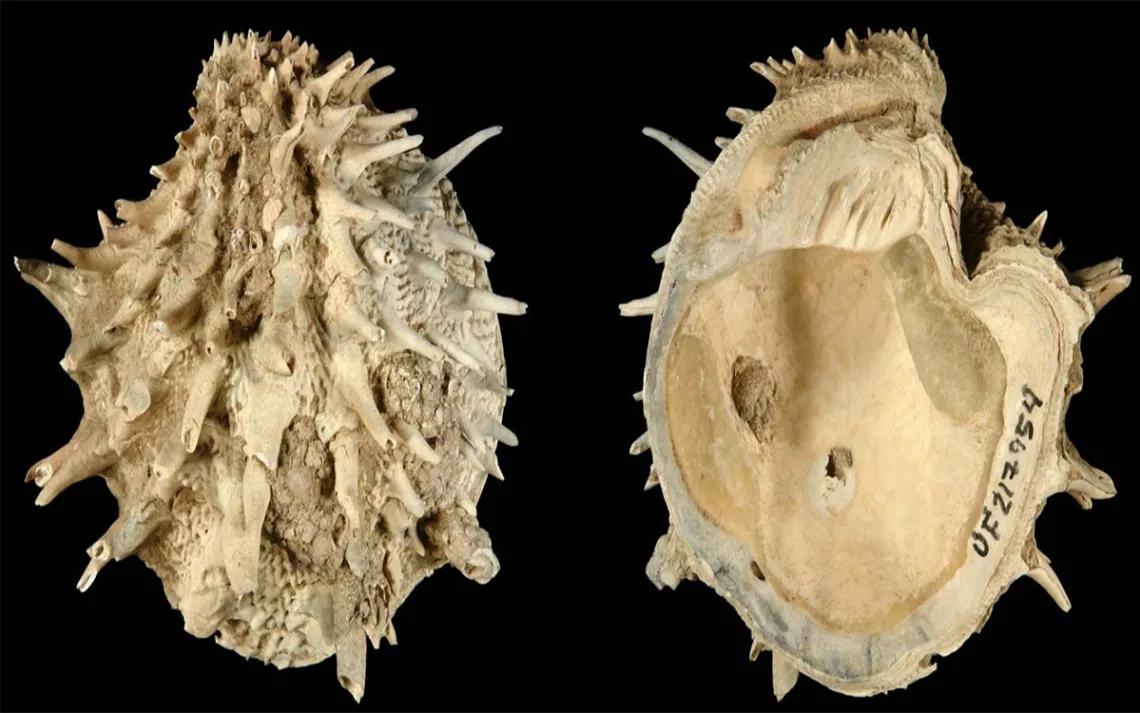How the Low-Energy Will Inherit the Earth
A new study suggests species with low metabolic rates avoid extinction longer

Photo courtesy of Neogene Atlas of Ancient Life/University of Kansas
According to the popular understanding of evolution, members of a species evolve to outsmart our constantly changing world—with the leopard running just a tad faster to catch the antelope, or the monkey reaching just a bit farther for the nut. That doesn’t necessarily mean the species survives longer. By most estimates, 99.9 percent of all species on Earth now only exist in the fossil record. So what makes one hang on for millions of years longer than another?
While random events like comet impacts, volcanic eruptions, and climate change all play a part, a new study suggests a lot has to do with metabolism.
Researcher Luke Strotz, a postdoctoral paleontologist at the University of Kansas, and his team took a look at mollusks in the western Atlantic Ocean over the last 5 million years. In that time period, lots of species have gone extinct, while a few have lasted to the present day. But unlike with other types of land animals and some sea creatures, which just leave some fragmentary bones behind, the hard shells of bivalves and gastropods give us a good record of just how large extinct species were.
Calculating the basal metabolic rate (BMR) of an animal, or the amount of energy a creature needs just to exist, is pretty straightforward. It’s a function of its size versus its temperature. Using measurements of the shells of 299 species from museums around the United States, the team was able to estimate the biomass of each mollusk in the study. Then, using what we know about temperature fluctuations in the oceans over time, they were able to estimate the BMR for each of the species. It turns out, the lower the BMR, the longer the species as a whole was expected to survive. The research appears in The Proceedings of the Royal Society B.
For Strotz, the finding was a surprise. Researchers already knew that BMR has an impact on the maximum life span of individual species—the more energy you need, the shorter the average longevity. But he didn’t think the same idea would translate to the species level.
“Often what we find in biology is that when we scale up across levels, concepts are bigger than the sum of their parts,” he says. “When we look at communities of organisms, we don’t necessarily expect them to be represented purely by all the individuals that make up that community. But in this case, in terms of physiology, it does seem metabolic rate says something about the maximum life span; it also says something about the extinction likelihood of a species.”
Strotz cautions that metabolism isn’t the only or even the primary driver of extinction, just one of many factors. For instance, the idea seems to apply mainly to species that inhabit a smaller geographic area. In species that are widespread, he found, metabolism doesn’t seem to matter quite as much. And if a comet hits the ocean near a colony of gastropods, their super-slow metabolism isn’t going to save them.
But when it comes to the slow, steady march of background extinction, in which the majority of species disappear or split into new ones over time, metabolism does make a difference.
“Maybe in the long-term, the best evolutionary strategy for animals is to be lassitudinous and sluggish—the lower the metabolic rate, the more likely the species you belong to will survive,” coauthor Bruce Lieberman, also of the University of Kansas, says in a statement. “Instead of ‘survival of the fittest,’ maybe a better metaphor for the history of life is ‘survival of the laziest’ or at least ‘survival of the sluggish.’”
The idea is not new. In recent decades, researchers have begun to examine life on Earth through their metabolism or energy systems according to the metabolic theory of ecology. On the level of the individual, the theory shows that constraints placed by an organism’s metabolism limit things like reproductive rates, hunting strategies, life span, and growth rates. Scaling up to the species level, it determines population size and population growth. The theory has even been investigated on the ecosystem level to explain the overall production of biomass.
John Schramski of the University of Georgia, who has studied the ecosystem level properties of the metabolic theory, says Strotz’s research makes sense viewed through that lens. “It’s very reasonable and plausible because the energetics are a non-negotiable aspect of the struggle for survival,” he says. “We live in the envelope of the laws of thermodynamics, and that helps define the boundaries of where acceptable biological actions can take place. You can’t violate the laws of thermo.”
Schramski says that the question the study doesn’t answer—and possibly never can since so many of the species are extinct—is how much energy is allocated to survival tactics, like acquiring food, mating, producing young, and avoiding predators, and how that impacts survival rates.
Strotz says that he hopes to work with other fossil records to see if BMR affects the extinction rates of other types of animals like fish. “Mollusks were a good group to begin with,” he says. “It could be a general principle of physiology, but it’s something that needs to be tested.”
So what does this mean for the future of humanity? It turns out that, according to a 2014 study in PNAS, humans and other primates only burn half the calories of other mammals of a similar body size, meaning we have a relatively low BMR. Which means, if this finding applies to mammals as well, we might hang in there a while longer—if climate change, nuclear annihilation, or a rogue comet don’t get to us first.
 The Magazine of The Sierra Club
The Magazine of The Sierra Club



